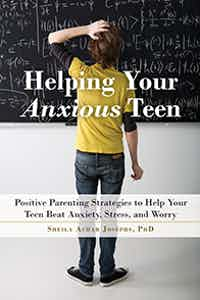By Sheila Achar Josephs, PhD
While exposure therapy has shown remarkable results for decreasing anxiety, clinicians often find it difficult to motivate teens to do challenging exposures. The benefits of continued avoidance along with a teen’s natural desire for autonomy often affects treatment participation. Teens not fully committed to exposure therapy may resist starting exposures, practice them inconsistently, or even discontinue treatment. Or, they may try to hold back on experiencing anxiety during exposures, which correspondingly will decrease the effectiveness of exposure treatments. Laying a solid foundation for exposure therapy is critical to its success.
Teens should first be educated about avoidance and how it brings temporary relief but ultimately serves to increase anxiety. It’s especially important to connect the dots in terms of how a client’s unique avoidance behaviors lead to a heightened sense of danger. For example, with socially anxious teens, discuss how their avoidance of social events prevents them from learning that these situations are not as catastrophic as they fear.
One useful method to foster motivation is to ask questions to help teens see the downside to all of their avoidance, such as:
- How has anxiety gotten in the way of doing the things that you really want to do?
- How much of your life has been taken over by anxiety
Along with emphasizing what is not working, questions can highlight the benefits of positive change, such as:
- What would be fun to try if you were not so anxious?
- How will your life be more joyful when you face your fears?
- What can you imagine feeling and accomplishing when your anxiety decreases?
Regardless of age, anxiety often prevents people from doing what they really want to do. So, it is often helpful to frame exposure therapy as a bridge to “getting what I really want.” For example, one socially anxious teen identified what she wanted to accomplish, but was too afraid to try: ask a teacher a question, introduce myself to someone new, tell a joke to a group of friends, etc. She then rank-ordered how anxiety-provoking each new behavior would be (on a scale from 1-10) and began practicing the behaviors from easiest to most difficult. Soon she was feeling more confident about math class after getting help, and made some new friends. Along the way, she learned that when avoidance gradually decreases, anxiety does so as well and there can be many positive outcomes—such as positive attention from others—of facing fears. The rewards of accomplishing easier exposures then naturally motivate clients to attempt harder ones.
 Sheila Achar Josephs, PhD, is a clinical psychologist and anxiety expert with over twenty years of experience helping kids, teens, families, and adults. She is founder of Princeton Cognitive Therapy, a practice specializing in cognitive behavioral therapy (CBT) for anxiety. She has helped numerous kids, teens, parents, clinicians, and school professionals learn cutting-edge strategies to overcome anxiety. She also enjoys presenting workshops on teen stress and resilience for parents.
Sheila Achar Josephs, PhD, is a clinical psychologist and anxiety expert with over twenty years of experience helping kids, teens, families, and adults. She is founder of Princeton Cognitive Therapy, a practice specializing in cognitive behavioral therapy (CBT) for anxiety. She has helped numerous kids, teens, parents, clinicians, and school professionals learn cutting-edge strategies to overcome anxiety. She also enjoys presenting workshops on teen stress and resilience for parents.


 2024 Peace Playbook: 3 Tactics to Avoid Clashes with Your Partner
2024 Peace Playbook: 3 Tactics to Avoid Clashes with Your Partner